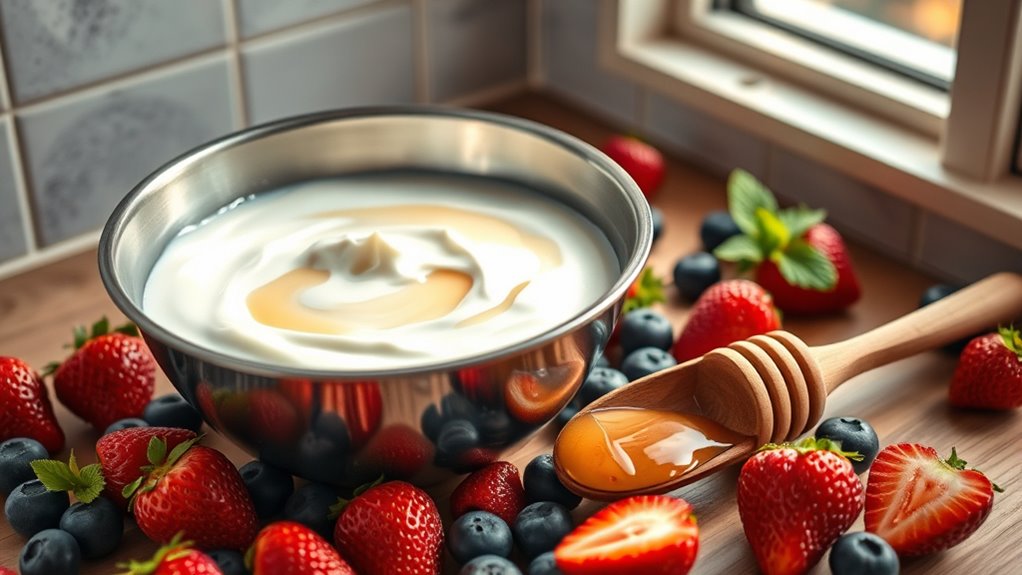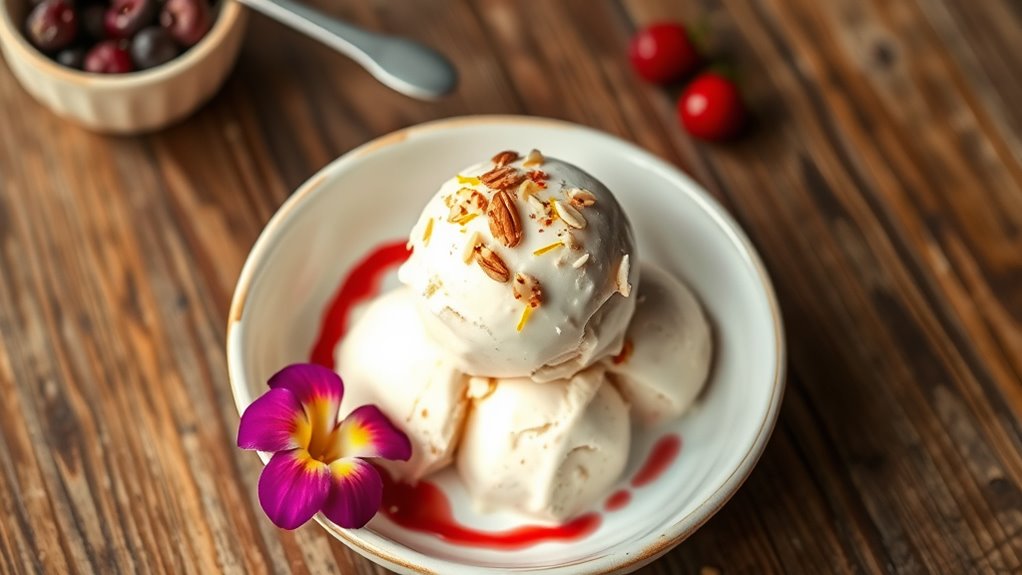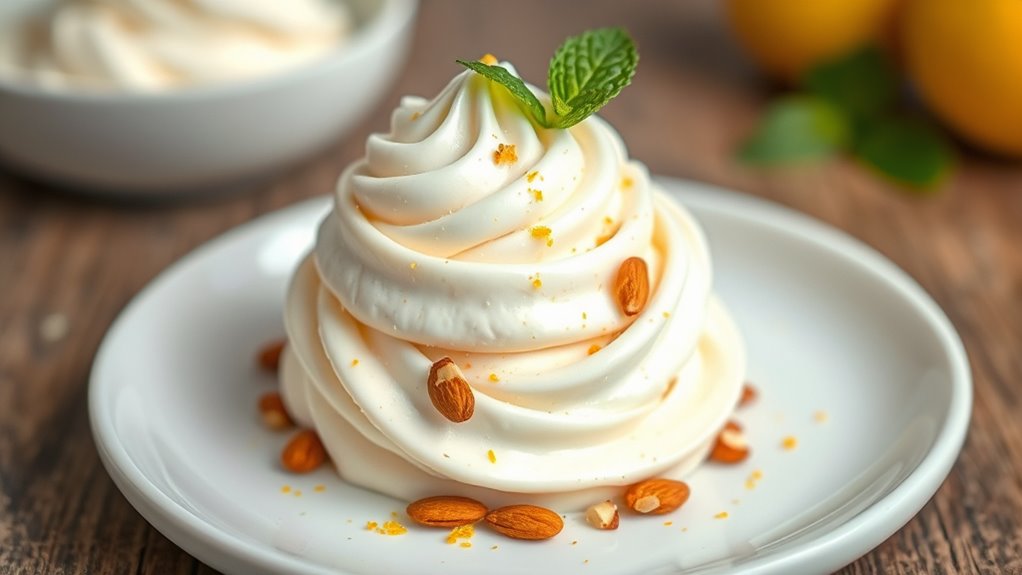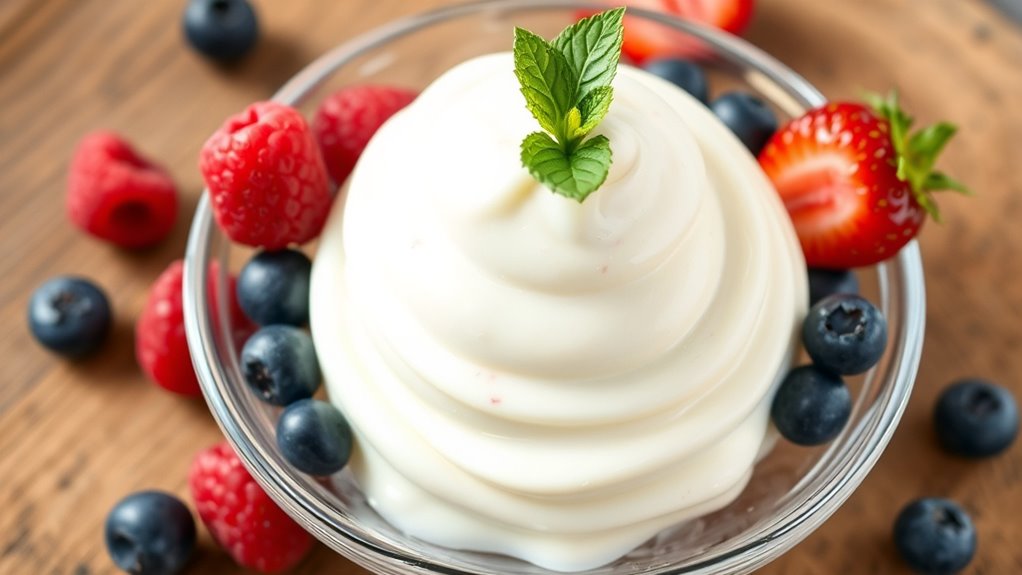Kefir ice cream blends kefir with a splash of cream for richness, then sweetens to balance tang. Start with 2 cups kefir and 1/2 cup cream, add 2–3 tablespoons sugar, and optional vanilla or citrus for brightness. Chill the base, then churn in a tightly sealed, chilled container, stirring every 20 minutes to curb ice crystal formation. Serve slightly softened at -8 to -6°C with crunchy toppings. If you keep exploring, you’ll uncover more tips and variations.
Ingredients and Quantity

For this kefir ice cream, you’ll need a base of two cups of kefir, plus half a cup of cream for richness. You’ll select kefir types that suit your texture and tang, then balance with precise flavor variations to taste. This section focuses on exact quantities and options without fluff, so you can scale confidently.
| Ingredient | Quantity | Notes |
|---|---|---|
| Kefir | 2 cups | Plain or lightly flavored |
| Cream | 1/2 cup | Full-fat for body |
| Sweetener | 2–3 tbsp | Honey, sugar, or syrup, to taste |
| Optional add-ins | Quantity | Purpose |
| Vanilla extract | 1 tsp | Elevates aroma |
| Flavor variations | as desired | Citrus, cocoa, or berries |
Preparations

To begin preparations, gather all ingredients and tools before you start, guaranteeing you can measure accurately without interruption. You’ll verify balance between kefir, sugar, and stabilizers, then align equipment with your workflow to maximize efficiency and control. Precision matters here, so focus on timing and temperature as you proceed, since these factors shape Kefir benefits and control Ice cream texture. You’ll formalize each step to minimize waste and inconsistency, keeping your environment calm and purpose-driven.
- Gather measuring cups, a whisk, and a chilled mixing bowl to guarantee consistent temperature.
- Pre-measure kefir, sugar, and stabilizers, labeling each portion for quick access.
- Set up a thermometer and timer to monitor heat and freezing intervals, preserving texture integrity.
How to Cook

- Gather all ingredients and set up your cooking tools.
- Temper sweetened kefir with a light sugar base to ensure even sweetness without graininess.
- Chill the mixture briefly.
- Whisk in stabilizers and a pinch of salt to enhance flavor and texture.
- Freeze the mixture gradually in a tightly sealed, chilled container.
- Stir every 20 minutes during freezing to break up ice crystals and promote a creamy texture.
- Use a temperature probe to monitor consistency, aiming for a soft-serve to firm texture depending on your freezer.
- Note that kefir benefits develop as fat and protein balance.
- Adjust flavorings and fat ratios to create different ice cream variations.
- Prioritize precision over speed for a refined, adaptable frozen dessert.
How to Serve

Serving kefir ice cream correctly enhances texture and flavor. You’ll optimize serving by balancing temperature, texture, and garnish to reinforce the dessert’s tangy profile. Consider how presentation ideas influence perception and enjoyment, not just taste. Your goal is consistency, so portion size and scoop quality matter as much as flavor.
Serving kefir ice cream hinges on temperature, texture, and tasteful garnish to heighten its tang.
1) Serving suggestions: serve slightly softened scoops at -8 to -6°C, allowing mild creaminess without iciness, and pair with a crisp contrast like toasted nuts or citrus zest.
2) Presentation ideas: choose a minimal plate or glass, drizzle a light syrup or fresh fruit coulis, and place a single herb or edible flower for color contrast.
3) Texture cues: present with a clean spoon, guarantee even distribution of air, and avoid clumping by gentle scooping just before plating.
Tips

Kefir ice cream benefits from practical, bite-sized guidance that directly improves results. You’ll optimize texture and flavor by respecting ratios: start with a base of kefir, cream, and a touch of sugar, then adjust thickness with a small amount of stabilizer if needed. Chill thoroughly before churning to reduce iciness. When you monitor sweetness, taste as you go, avoiding oversweetness that masks Kefir health benefits. For consistency, freeze in shallow layers and churn in batches to prevent overrun. Explore Ice cream variations by adding vanilla, citrus zest, or berries after the churn for brightness without compromising structure. Keep notes on processing times, temperatures, and ingredients to refine future batches and sustain Kefir health without sacrificing complexity.
Food Value and Benefit
Kefir ice cream offers a nutritious and delicious way to enjoy a probiotic-rich dessert that supports overall health.
Food Value:
This dish combines the beneficial probiotics found in kefir with controlled amounts of sugar and fat, providing a balanced source of energy and essential nutrients. It contains dairy protein which promotes satiety without excessive calories, along with important vitamins and minerals derived from milk.
Benefits of Eating Kefir Ice Cream:
- Supports gut health through live probiotics that aid digestion and enhance immune function
- Provides calcium for strong bones and teeth
- Supplies B vitamins, including B12 and riboflavin, which are essential for energy metabolism
- Contains dairy protein that helps maintain fullness and supports muscle repair
- Offers a modest amount of lactose, making it easier to digest for some lactose-sensitive individuals
- Helps balance energy intake when consumed in appropriate portions, supporting weight management and recovery
Key Vitamins and Minerals:
- Calcium
- Vitamin B12
- Riboflavin (Vitamin B2)
- Phosphorus
- Potassium
Frequently Asked Questions
Can Kefir Replace Dairy in All Ice Cream Bases?
Kefir can partially replace dairy in many bases, but not universally. You’ll notice texture and flavor shifts. Kefir benefits include tang and tangy creaminess; dairy alternatives work best with adjustments to fat, sugar, and stabilizers for balance.
What’s the Best Freezing Method for Smooth Texture?
You’ll get a creamy consistency by choosing proper freezing techniques, avoiding ice crystals through rapid chilling and churned emulsification. You’re chasing smoothness, so monitor temp, whisking intermittently, and sealing air pockets as you freeze for best texture.
How Long Does Dairy-Free Kefir Ice Cream Last?
Dairy-free kefir ice cream lasts about 1 to 2 months in the freezer when kept airtight. For best quality, label with date, store at a consistent temperature, and follow shelf life and storage tips to prevent freezer burn.
Can Kids With Lactose Intolerance Enjoy Kefir Ice Cream?
Yes, you can enjoy it if lactose digestion is gentle, but check labels. You’ll savor the allegory of a friendly dairy-visitor—probiotic benefits while watching lactose tolerance. You decide, balancing freedom with mindful lactose considerations.
Is Alcohol Needed for Flavor Stability in Freezing?
Alcohol isn’t required for freezing stability. You can rely on alcohol substitutes to aid evaporation and pliability, while emphasizing flavor preservation; balance sweetness and texture, ensuring freezing remains uniform without compromising your freedom to experiment.
